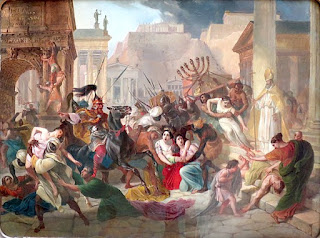Priscillian (c.340 - 385) was a good enough theologian that he was made Bishop of Ávila Spain in 380, but controversial enough that he had many enemies among his fellow bishops. His preaching of a life of strict asceticism—including fasting on Sundays and Christmas, avoiding meat and wine, celibacy, etc.—especially annoyed Bishop Hyginus of Corduba (Cordova) and Bishop Hydatius of Augusta Emerita (Mérida, Spain), who accused his ideas of being Gnostic.
In fact, Priscillian did get his ideas from Marcus, a native of Memphis in Egypt, who came to Spain and taught Gnostic theories. We don't know if Marcus and Priscillian had direct contact, but apparently Priscillian was converted by two of Marcus' followers, a woman named Agape and a rhetorician named Helpidius. Priscillian's rhetorical gifts helped convert others to take an oath to follow his lifestyle, including a couple bishops, Instantius and Salvianus.
A synod of 380 held by Hyginus and Hydatius pronounced Priscillian, Helpidius, Salvianus, and Instantius as rejected from the faith of Christianity. This is the first known example of excommunication in the Christian church. A Bishop Ithacius of Ossonoba (Faro, Portugal) was given the task of making the heretics mend their ways. He failed, and this was the motivation for Instantius and Salvianus to defy the synod and elevate Priscillian to bishop.
In retaliation, Ithacius appealed to Roman Emperor Gratian, who had recently along with Theodosius issued the Edict of Thessalonica, making Nicene (Catholic) Christianity the only approved form in the Roman Empire. Gratian deprived the Priscillianists of their churches and sent them into exile. The persecuted bishops decided to go to Rome and appeal to Pope Damasus I who, like them, was from Iberia. Damasus denied them an audience, however, so they went to Milan to appeal to the popular St. Ambrose, who had a reputation for standing up to the emperor, but he likewise would not meet with them.
Their next step was bribery at the Imperial Court, which did work: they got their churches back and the exile lifted. They also got Ithacius exiled from Iberia; Ithacius appealed to Gratian, but before he could get help, Gratian was killed and Magnus Maximus became emperor. Maximus wanted to have the orthodox bishops on his side, so he called for a synod in Bordeaux in 384 during which Ithacius was so vehement in his condemnation of Priscillian et alia that St. Martin of Tours got involved, annoyed that what he considered an ecclesiastical issue was being dealt with by a secular authority. Martin got the emperor to agree that the synod would not result in shedding blood.
Martin left the synod, however, and the emperor's prefect Evodius was appointed judge in the case. Evodius decreed that Priscillian and the others were guilty of practicing magic (possibly because of the Gnostic origins of Priscillianism), and the Priscillianists were condemned to death. Priscillian may well be the first excommunication and the first execution for heresy.*
Priscillianism was not done with, however. St. Martin returned to the emperor and stopped him from sending military to Iberia to exterminate the heretics they would find.Ambrose sternly denounced the handling and result of the situation.Some of the Gallican bishops denounced Ithacius and his behavior. A synod of Iberian bishops eventually deposed Ithacius; Hydatius was compelled to resign.
The executions (some would say martyrdom, of course) caused Priscillianism to grow. A synod in 400 in Toledo actually reconciled some Priscillianist bishops to the Church, one of whom wrote a moral treatise from the Priscillianist viewpoint. The advance of the Vandals into Iberia helped spread Priscillianism as the adherents fled before the invaders. Attempts by Augustine and Pope Leo I to suppress the movement failed. It took the 561 First Council of Braga that specifically targeted its doctrines to get it to die out.
So what was so dangerous about Gnostic ideas? Let's talk about that next time.
*And now I have fulfilled the promise ibn the footnote of that post.







